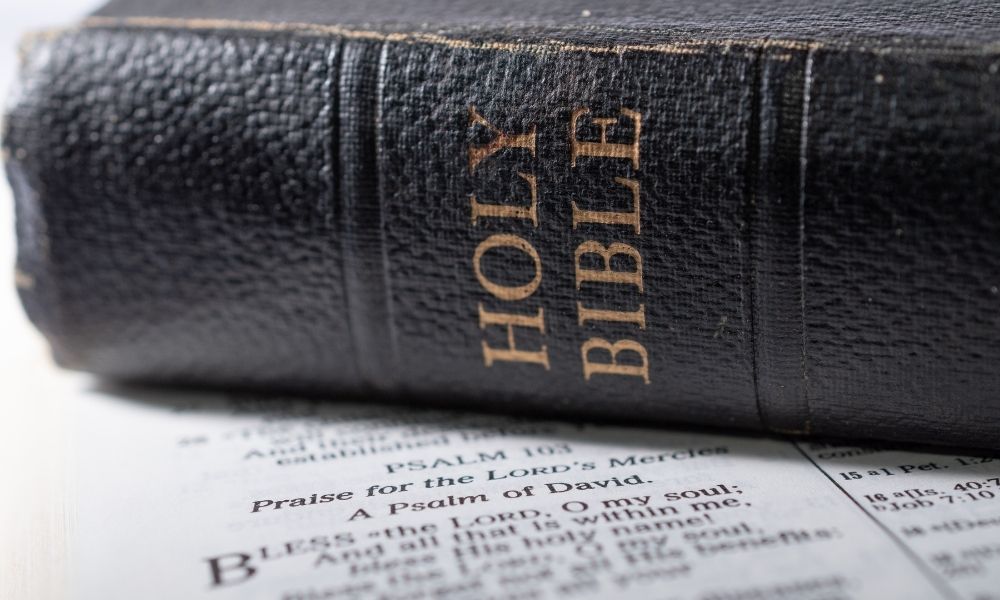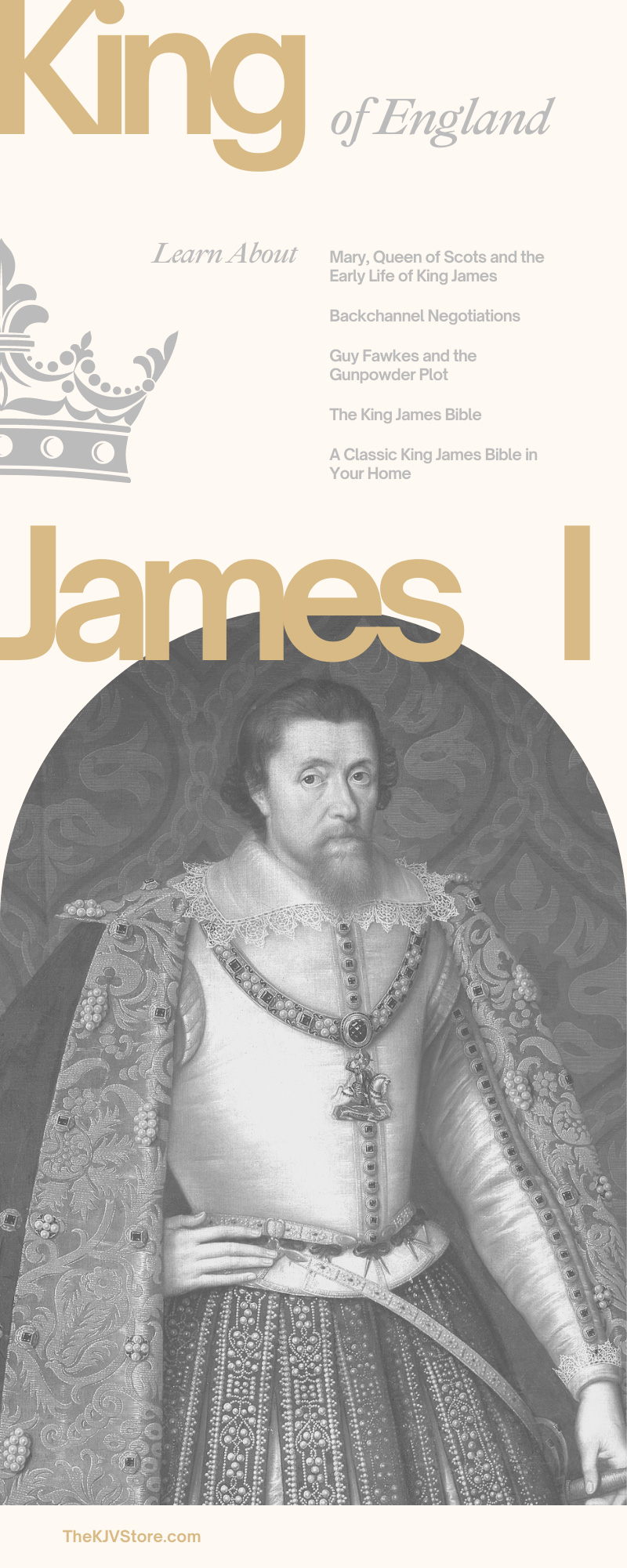Who Was King James I of England?

You needn’t be a subject of the Crown to know some of the most influential holders of the English monarchy. There are, of course, the two Elizabeths: Elizabeth I, the “Virgin Queen,” whose rule saw England’s cultural and exploratory golden age, and Elizabeth II, the reigning queen and the world’s longest-reigning head of state. Queen Victoria is synonymous with upright morality and a British Empire upon which the sun never set. Henry VIII landed the first blow against the hegemony of the Roman Catholic Church when his attempts to divorce Catherine of Aragon necessitated the elaborate end-run of establishing the Church of England.
No less familiar to Christians around the world, if only by name, should be King James VI and I—that’s the sixth of Scotland and first of England, as we’ll discuss. Even if you’ve declined the King James Version Bible in favor of the New International Version, the American Standard Version, or the Good News Bible, you should still be familiar with the KJV’s unshakable position in the Western canon. It has acted as a forefather of Bible translations to come and as an inspiration for centuries of English storytelling. But who was King James I of England, and how did he come to have his name associated with this cornerstone of English literature? Did he write this Bible himself, did he commission its translation, or did he simply demand credit as a condition of his monarchy? We’ll take a closer look at the life of a man who was a transformational figure, not only for the isle of Britain but for the entire Anglosphere and global Christendom.
Mary, Queen of Scots and the Early Life of King James
James was born on June 19, 1566, in Edinburgh to Mary, Queen of Scots, a legendary monarch in her own right. As a Catholic ruling over a largely Presbyterian Scotland, Mary struggled to gain legitimacy among her subjects. They saw her as an interloper who was unfamiliar with the Scottish way of life, owing to her French upbringing and Catholic faith. In 1567, just thirteen months after James’s birth, Mary would abdicate the Scottish throne in favor of her son, who would nominally hold the throne in infancy while under the regency of various Scottish earls.
Mary, who had hoped to ascend to the English throne, was a rival to Elizabeth I of England, who imprisoned Mary for treason against the English crown. She had Mary executed in 1587, ending a tragic life marked by lost romances and personal tragedies. By this time, James VI of Scotland had fully ascended to the throne. In 1603, Elizabeth I would die childless without establishing a clear heir to the throne. However, the Treaty of Berwick of 1586 had outlined a working agreement between the two Protestant kingdoms of England and Scotland to protect their shared island from the Catholic power of mainland Europe. This treaty implied that this alliance could lead to a unification of the thrones.
Backchannel Negotiations
To the most powerful actors in the English government, this was more than an implication. Sir Robert Cecil, Elizabeth’s Secretary of State, told James VI of Scotland that he favored James as the heir to the throne. Upon Elizabeth’s passing, James would indeed ascend to the throne without abdicating his position as King of Scotland. In this personal union, James would rule over both kingdoms simultaneously without merging one into the other, as some feared at the time. This arrangement made him somewhat confusingly James VI of Scotland and James I of England. However, the system of one king for two kingdoms did not suit the newly empowered king, who sought to style himself as the “King of Great Britain.” It soon became clear that even as a Scot, he saw England as the senior partner in the union and aspired to govern the entirety of the island under the English Crown and English Parliament. In due time, this fate would befall once-independent Scotland.
Guy Fawkes and the Gunpowder Plot
Parliament was the site of much attention in 1605 when a group of English Catholics attempted to detonate an excess of gunpowder and demolish the venerable Westminster Palace. Their ultimate goal was to assassinate King James for what they felt was the mistreatment of Catholics in England. Despite their misgivings, James had been comparatively tolerant of English Catholics, though he did have a hands-off attitude toward anti-Catholic persecution. The plot failed when a member of the House of Lords tipped James about a warning he had received. Investigators discovered gunpowder and captured conspirator Guy Fawkes, who, under torture, confessed to the plot and gave up his co-conspirators. The effigies of Fawkes that English Protestant celebrants would burn inspired our use of “guy” as a generic term for a male.
The King James Bible
The longstanding Jacobean contributions to the English language would by no means end with “guy.” As king of two Protestant nations, James understood well the importance of making the Bible readily accessible to believers. English Puritans and other Anglicans found fault in the earliest attempts to translate the Hebrew and Greek texts of the Bible to the English language. In January 1604, James and the Church of England convened the Hampton Court Conference. This was an attempt to begin coordinating with Puritans to achieve an accord regarding the proper translation of the Bible. From there, James would gather an estimable committee of theologians and clergy members to undertake the work of translating the Old and New Testaments into English. The result of their years of work would come to be known at its 1611 publication as the Authorized Version, for the crown only authorized people to read this translation in the Church of England. Today, we know it better by the name of the king who took the great step of commissioning such a work of literary beauty. It is the King James Version. This translation’s distinct turns of phrase have endured in the English language and literature for centuries.
A Classic King James Bible in Your Home
The King James Version Bibles of yore were built to last, with elaborate illustrations and print set within gorgeous leather bindings. Today, you can enjoy this same quality in your own home with premium leather Bibles from The KJV Store. Now that you have a deeper understanding of who King James of I England was and why he was so important to the Bible’s history, you can add to that history with a King James Version Bible of your own.

